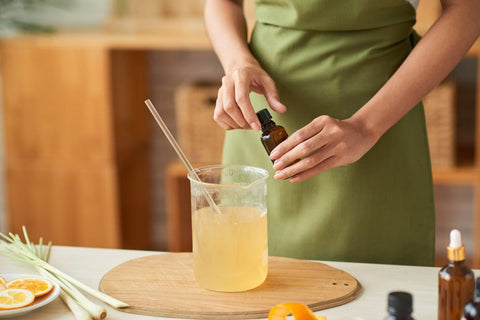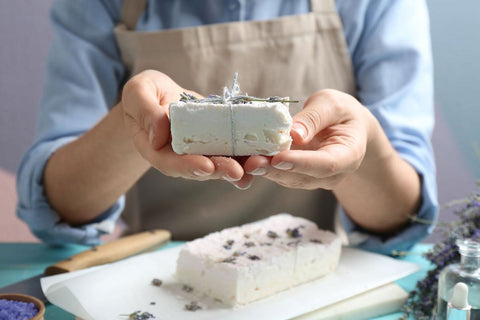Do you need mild, all-natural soap for your daily hand washing, body washing, shampoo, dish soap, and so on? Then a liquid castile soap recipe is ideal for you. This pure Homemade Liquid Castile Soap Recipe is simple to produce and gentle because it is made entirely of olive oil.

It's ideal for cleaning the face and body and around the house. Liquid castile soap is more versatile, less expensive, and more environmentally friendly than the competition. Check out this simple DIY recipe for making liquid castile soap at home.
How To Make Liquid Castile Soap At Home?
Liquid castile soap has many applications, such as hand washing, body washing, shampoo, dish soap, or shower scrub. So, let's see how to make liquid castile soap at home. DIY recipe.
Ingredients:
- Virgin Olive Oil - 1200 ML
- Distilled Water - 950 ML
- Potassium Hydroxide Lye Flakes - 260 Grams
Directions:
Step 1: Add 1,200 mL of olive oil to your slow cooker on high heat. Add 1,200 mL of olive oil to your slow cooker using a measuring cup. Then, on high, heat the oil in the slow cooker.

Step 2: Put on safety gloves and eyewear in a well-ventilated area. Wear protective gloves and goggles while the oil is heating up to protect your skin and eyes. Then, switch on the vent hood and open one or two windows to ventilate your space.
Step 3: Combine the potassium hydroxide lye flakes and distilled water in a mixing bowl. Using a measuring cup, pour 950 mL of distilled water into a large glass mixing bowl. Then, gently add 260 g of potassium hydroxide lye flakes to the distilled water. Mix the lye solution with a silicone spatula, stirring slowly and carefully until the flakes dissolve.
Step 4: Combine the oil and lye solution in the slow cooker. First, stir the oil heating up in the slow cooker with your spatula to ensure it's warm and combined if you use more than one type of oil. Then, slowly pour the lye solution into the slow cooker, careful not to splatter it.
Step 5: Blend the oil and lye together with an immersion blender. In the slow cooker, insert the end of your immersion blender. Then, on medium, blend the liquids for about 5 minutes, swirling the blender around in the slow cooker to ensure that all oils and lye solution are combined.
Step 6: Cook the Liquid Castile Soap Recipe for 3 hours, stirring every 30 minutes. Set your slow cooker for 3 hours when the soap mixture thickens. Cover the slow cooker and return after 30 minutes to stir the stew with a silicone spatula.

Step 7: Add 14 g of the soap mixture to hot water to evaluate the clarity. Check the soap after about 3 hours to see if it is translucent and has a gel-like substance. If it does, pour 14 g of the soap concoction into 30 mL of hot water with a measuring spoon. The soap is ready to be diluted if it melts and stays translucent.
Step 8: Heat 10 cups (2,400 mL) of distilled water on the burner. Add 10 cups (2,400 mL) of distilled water to a saucepan using a measuring cup. Then, on the burner, heat the water until it boils.
Step 9: 10 cups (2,400 mL) of hot distilled water should dilute the soap concoction. Pour the hot distilled water gently into the slow cooker to avoid splashing it on your skin. Then, using a silicone spatula, mix the detergent and distilled water.
Step 10: Cover the slow cooker and simmer for 8 hours. Set your slow cooker to "keep warm" once the soap concoction has been diluted with hot distilled water. Allow the soap to liquefy for at least 8 hours, preferably overnight.
Step 11: Pour the liquid castile detergent into your chosen container(s). Transfer the Liquid Castile Soap Recip to a large glass container with a ladle or divide it among several smaller soap dispensers. Your liquid castile detergent can be used as a cleaning solution, hand cleanse, body wash, shampoo, dish soap, or shower scrub.

Coconut Oil Liquid Soap Vs. Liquid Castile Soap
Coconut oil liquid and liquid castile soap have only a few parallels. Both liquid soaps are suitable for cleansing, handwashing, and personal hygiene. Let's look at the differences.
1.) Coconut oil liquid soap, as the term implies, is made with virgin coconut oil, whereas liquid castile soap can be made with any vegetable oil, such as virgin olive oil, hemp oil, and so on.
2.) They also have different characteristics. Coconut oil liquid detergent has a more vital cleansing ability and is better suited for oily or acne-prone skin. On the other hand, Liquid Castile soap is gentler and more moisturizing, making it ideal for dry or delicate skin.
3.) Regarding sustainability, homemade liquid Castile soap is frequently regarded as a more environmentally friendly choice due to its use of natural and biodegradable ingredients. In comparison, coconut oil liquid soap may be made with palm oil, which has been linked to deforestation and habitat destruction.
Conclusion
In conclusion, coconut oil liquid and Castile soap are efficient cleanings and personal care products. Nonetheless, the decision between the two will be influenced by personal tastes, skin type, and environmental concerns. Use the finest ingredients to create the best liquid castile soap. Visit VedaOils.com for high-quality soap-making kits and ingredients at competitive rates.
Frequently Asked Questions
Some frequently asked questions for our amazing readers. To give you more clearance as we care for your queries.

Q1: What Is Unique About Castile Soap?
Ans: Castile soap is an incredibly flexible vegetable-based soap free of animal fats and synthetic ingredients. This natural, nontoxic, biodegradable soap comes in bar and liquid versions.
Q2: How Long Does Liquid Castile Soap Last?
Ans: Since castile soap is ultra-concentrated, a large bottle can last very long. However, keep in mind that it has a three-year shelf life. The oils may become rancid after this time.
Q3: Can You Use Castile Soap For Everything?
Ans: Castile soap is suitable for scrubbing the body and hair, but it may also be used as an all-purpose cleaner for cleaning the house, washing clothes, and cleaning makeup brushes and sponges.











 Sign in
Sign in Register now
Register now My Reward Points
My Reward Points









